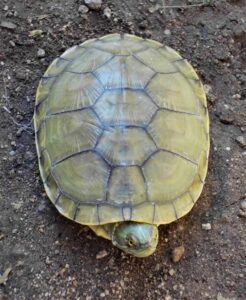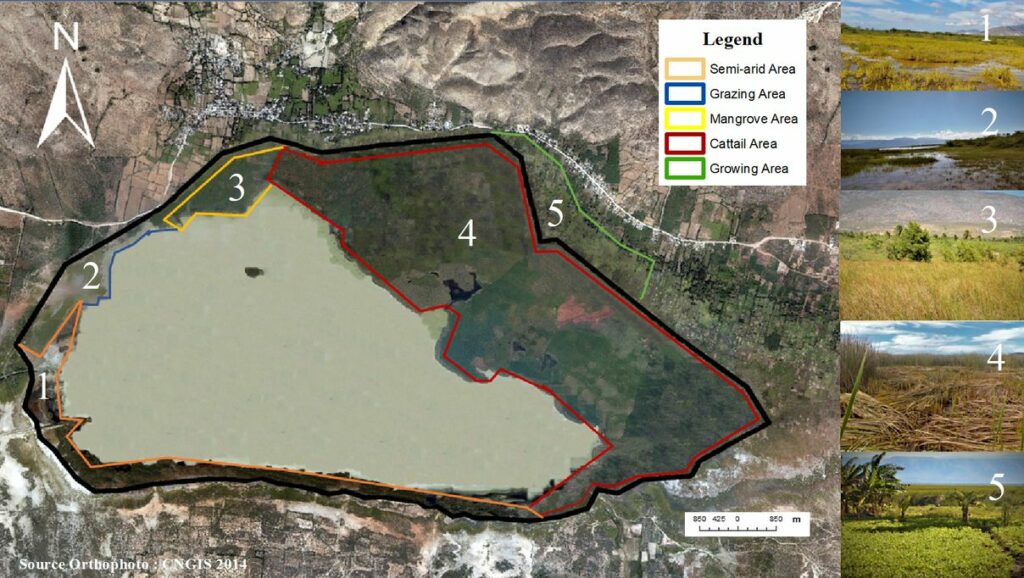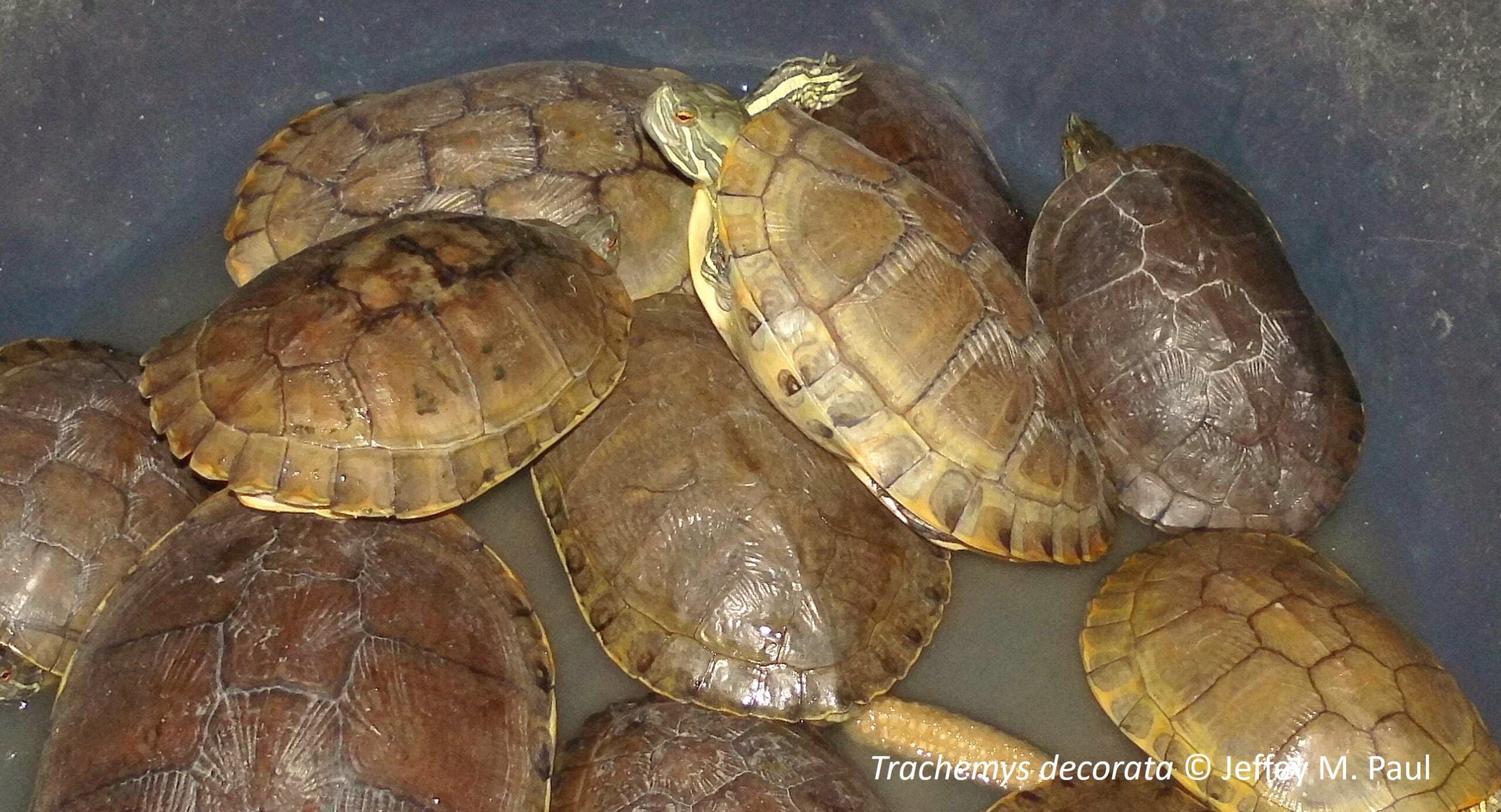Freshwater turtles are among the most endangered species in the world. In Haiti, a recent study focused on a particular threat to the local species Trachemys decorata: its exploitation for a wide variety of uses linked to the socio-cultural context of the region.
Trachemys decorata is an endemic freshwater turtle of Hispaniola, an island shared between the Dominican Republic to the east, and Haiti to the west. The species, like many freshwater turtles around the world, faces many threats including habitat destruction and competition or hybridization with other invasive turtles. The species is also subject to some form of exploitation and can be found in the markets of the towns and villages of Haiti. However, the importance of the trade in these turtles, and especially that of the local demand for different uses, remains little known, and it is difficult to assess its impact on the conservation of the species.

Trachemys decorata
In Haiti, the historical, religious, and cultural context leads to specific practices towards plants and animals, such as their use in traditional medicine or in religious practices. To better understand the impact of the socio-cultural environment on the conservation of the species, two young Haitian researchers conducted a study on the marketing and use of the turtle in the vicinity of the Trou Caiman pond, one of the most important in the country.
For several months, the authors observed the relationship between the local population and freshwater turtles. They interviewed dozens of residents in Creole, whose activities are representative of the local population, including among others many fishermen, voodoo priests or religious practitioners and merchants (fish, turtles).
The turtles caught in the lake turn out to be opportunistic catches: no fisherman is specialized in catching turtles. However, as already shown by a previous study conducted by the same authors (read the article), turtles present a real commercial value, since the demand is both important and regular.
The use of turtles is quite diverse. First of all, they are appreciated for their meat by the local population, and enter in the composition of several local recipes. The same goes for their eggs, to a lesser extent. Turtles are also of interest to craftsmen in large cities, who transform the shells into decorative objects or necklaces, particularly appreciated by voodoo practitioners.
Turtles can also be kept alive. They thus become pets, especially for customers from large cities, or for fishermen who keep them for their children. They are also used to purify water in hand-dug wells. Locals use them regularly to rid the water of insects and other aquatic invertebrates, and often think that the turtles also consume the mud at the bottom of the well. This use has health consequences due to the droppings of the turtles in the water which will then be used for cooking, but also its contamination when the animals die.
Finally, turtles have spiritual significance, and their use is closely tied to voodoo rituals and mysticism. In rural areas, hougans (voodoo priests) and mambos (their female counterparts) still have a large influence within their communities. In temples, turtles are placed in sacred pools dedicated to voodoo spirits. They are also used as means of protection against evil forces, in particular the lougarous. These female vampiric characters inspire fear in rural Haiti, especially for the survival of newborns. The blood and flesh of turtles are thus eaten by pregnant women as protection against lougarous, while their fat is applied to young children as an ointment. The authors also document other uses of turtles as part of the Voodoo religion, illustrating their importance to local beliefs.

Situation of the Trou Caiman pond in Haïti.
The diversity of turtle uses in Haiti highlights, according to the authors, the complexity of developing conservation strategies for species of economic and cultural importance, particularly in developing countries. The study highlights in particular the existence of a conflict between religious practices and the conservation of the species, and the need to take this specific dimension into account when developing a conservation plan for T. decorata in Haiti.
Prohibiting the capture of turtles in rural areas of Haiti seems indeed unrealistic given the current context of poverty, high food demand and spiritual beliefs. The authors propose alternative strategies that would be beneficial for both the inhabitants and the species, in particular with the development of an ecological breeding program for turtles in captivity, coupled with rice cultivation, and associated with an educational program to raise awareness among inhabitants to conservation and animal welfare issues.
Reference
Paul, J.M., Saint-Louis, L.J. & Cézilly, F. (2023). Commercialization, vodou ritual, and use of the endangered Hispaniolan Slider, Trachemys decorata, in Haiti: implications for conservation. Chelonian Conservation Biology 22: 68-79.
About the authors
Of Haitian nationality, Jeffey M. Paul holds a degree in agricultural engineering and a master’s degree in ecology. He is currently conducting a doctoral thesis at the Université des Antilles, thanks to the support of the Caribaea Initiative, on the different species of Trachemys turtles found in the insular Caribbean. He benefited in the field from the support of Lens J. Saint-Louis, also holder of an agricultural engineering degree and whose work on the birds of Haiti has also benefited from the support of the association.

